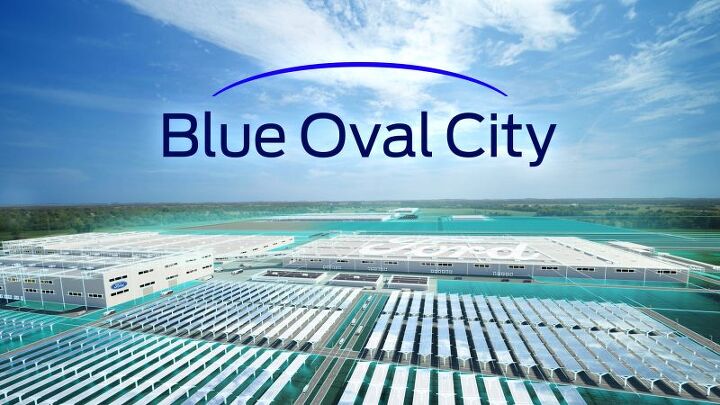Ford to Build Blue Oval City for EV Production

Ford has grand plans for building EVs and batteries, and the Blue Oval brand laid out those plans earlier this week.
Welcome to Blue Oval City
Blue Oval City is the name of the facility that Ford plans to build on a site in western Tennessee that is nearly six square miles. The company will build electric F-Series trucks and electric-vehicle batteries on this site.
Meanwhile, another facility, called BlueOvalSK Battery Park due to Ford’s collaboration with SK Innovation, will be built in central Kentucky, and it will have two battery plants. The batteries built there will be used in future Ford and Lincoln EVs, the company says.
Companies say a lot of things, and among Ford’s promises are $11.4 billion in investment and the creation of 11,000 jobs across the two facilities, which are set to be built near Stanton, TN, and Glendale, KY. Six thousand jobs are set for the Tennessee facility and 5,000 for Kentucky.
Production of both vehicles and batteries at both facilities is slated to start in 2025. All these grand plans are subject to regulatory approval and other conditions. Gotta dot the i’s and cross the t’s.
“This is a transformative moment where Ford will lead America’s transition to electric vehicles and usher in a new era of clean, carbon-neutral manufacturing,” said Ford Executive Chair Bill Ford in a statement. “With this investment and a spirit of innovation, we can achieve goals once thought mutually exclusive – protect our planet, build great electric vehicles Americans will love and contribute to our nation’s prosperity.”
“This is our moment – our biggest investment ever – to help build a better future for America,” said Jim Farley, Ford president and CEO, in the same press release. “We are moving now to deliver breakthrough electric vehicles for the many rather than the few. It’s about creating good jobs that support American families, an ultra-efficient, carbon-neutral manufacturing system, and a growing business that delivers value for communities, dealers and shareholders.”
Ford is aiming to have the plants be carbon neutral from jump, and recycling components is a key part of that effort.
Additionally, Ford is investing $90 million in Texas and $525 million across America on training technicians on how to repair EVs over the next five years.
We often rip automakers for making grand yet vague claims about their EV future, and while Ford is certainly presenting the most optimistic version of its plan here, it should be noted that at least it has a concrete plan. Lots could go wrong, of course. The promised jobs numbers could fall short. The plant(s) might not be as environmentally friendly as promised. The development of battery tech might move more slowly than planned.
All that said, at least Ford seems to have a plan, one that could become real soon enough. It’s unclear when shovels will break ground, but we expect this plant plan to be more than just vaporware backed by nice renderings.
Ford might just be positioning itself well for the projected coming market shift to EVs.
[Image: Ford]

Tim Healey grew up around the auto-parts business and has always had a love for cars — his parents joke his first word was “‘Vette”. Despite this, he wanted to pursue a career in sports writing but he ended up falling semi-accidentally into the automotive-journalism industry, first at Consumer Guide Automotive and later at Web2Carz.com. He also worked as an industry analyst at Mintel Group and freelanced for About.com, CarFax, Vehix.com, High Gear Media, Torque News, FutureCar.com, Cars.com, among others, and of course Vertical Scope sites such as AutoGuide.com, Off-Road.com, and HybridCars.com. He’s an urbanite and as such, doesn’t need a daily driver, but if he had one, it would be compact, sporty, and have a manual transmission.
More by Tim Healey
Latest Car Reviews
Read moreLatest Product Reviews
Read moreRecent Comments
- Fahrvergnugen The only GP we watch - and attend - is SailGP. Feeds a slightly different bunch of adrenaline junkies, though there must be some overlap.
- SCE to AUX Fisker filed for reorganization in Austria - the end is near.https://insideevs.com/news/718875/fisker-reorganization-austria/
- Bd2 I'll watch F1 when Kia and/or Hyundai pony (pun intended) up the cash to field a class leading team. Hyundai is leading many series with the Elantra N with it's incredible 350HP Smartstream-N engine.
- MaintenanceCosts More or less an admission that the radar-only cars will never do anything that could reasonably be marketed as "Full Self-Driving."
- Bd2 The coolest true SUV on the market. Change my mind.


































Comments
Join the conversation
@el scotto--Agree but I am not there yet. Still waiting for battery technology to improve, the infrastructure to expand, and more affordable selection. I am usually a late adopter of all technology including CDs, DVDs, flat screen TVs, and my 2012 Buick LaCrosse E-Assist (hybrid). I never had a muscle car but I had a 77 Monte Carlo, 84 5th Avenue, 78 Buick Regal Limited, 2000 Taurus,various compact cars, and 5 different pickups mostly compact and midsize.
Ford should add a microchip making facility to Oval City as well.